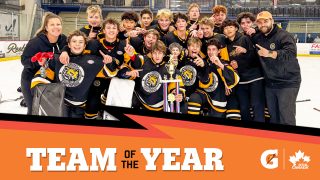Whether you’re playing house league or “AAA”, it’s always important your to ensure you’re starting the season right, and that starts with the proper equipment. Here’s what you need to know to guarantee you stay safe and comfortable on the ice. To start, here is a checklist of the equipment every child in the GTHL needs:
 Full-cage helmet
Full-cage helmet
 Mouth guard (optional)
Mouth guard (optional)
 Neck guard
Neck guard
 Shoulder pads
Shoulder pads
 Elbow pads
Elbow pads
 Gloves
Gloves
 Jock or Jill
Jock or Jill
 Hockey pants
Hockey pants
 Shin guards
Shin guards
 Skates
Skates
 Long garments
Long garments
 Hockey stick
Hockey stick
 Hockey bag
Hockey bag
 Hockey tape for socks and skates
Hockey tape for socks and skates
Goaltenders require additional equipment such as a chest protector, knee guards, blocker, catcher’s glove, mask, and specialized skates and stick. For helmets, whether purchasing new or used, they need to be CSA (Canadian Standards Association) approved. Nicole Howe, Eastern Regional Trainer and Corrie Telfer, Western Regional Trainer from Pro Hockey Life advises, “You should be able to feel the helmet is there, but no pressure, this means the helmet is too tight. With the helmet on, you shake your head up and down, back and forth to ensure no unnecessary movement is happening. The player’s visibility should not be impeded.”
It’s important all equipment fits properly upon purchase and shouldn’t be grown in to. A good indicator of fit is ensuring equipment does not slide out of position and covers the entire area. This will allow for maximum protection, covered by shoulder pads including chest, shin pads, and elbow pads. Pants need to extend down to the shin pad, covering both the tailbone and thigh area. Unlike other pieces of equipment, a common guideline when fitting pants is to purchase them one size bigger.
While the most expensive item will be skates, the right pair will be a difference maker. When getting fitted for skates, Jeff Campbell, the Coordinator of the GTHL’s Initiation Program recommends there is enough room for a child to wiggle their toes and for an adult to slip a finger behind the foot. Campbell says, “Skates especially should never be too big or too small. Both cause problems in skating and stride development that is crucial to the young or first-time player.”
With a never-ending choice of colours, patterns, and models, choosing the right stick can be confusing. Since prices vary greatly, the level of hockey will determine how much money needs to be spent. Finding a properly fitted stick is important for puck control and shooting skills. Campbell recommends, “I firmly believe a child needs a stick that will be right for their age and ability/
proficiency, their physical size, and the right weight, lie and feel for the kid to shoot and deliver as well as take a pass.” He also warns against purchasing a stick in need of a massive cut to shorten as for every half inch taken off a composite or wood stick, it will raise the stiffness and flex.
“Equipment should be replaced as the player outgrows them,” explains 2018-19 GTHL Trainer of the Year and Don Mills Flyers AAA Head Trainer Marshall Bacon. “Equipment should always fit comfortably and be the proper size for best protection. Any piece of equipment should be replaced if it is worn out, has holes or cracks in it. As the player moves into a higher level of play (from A to AA or AAA) they also may want to ‘upgrade’ their equipment for optimum protection.”
Inevitably, as kids grow and equipment endures its fair share of ice time it will need to be replaced. Keeping equipment clean by airing it out after every use helps to preserve its lifespan by stopping harmful bacteria from growing. Once you find the perfect equipment, taking the time to keep it clean will save a dime down the road. No piece of equipment will last forever, so enjoy it while you can.
WITH PRO HOCKEY LIFE
Pro Hockey Life wants to ensure we are setting every customer up in the right fit every time, focusing on your needs. To do this we want to know as much about your playing style as possible.
HELMETS:
-Placing the helmet on we will be looking for key fitting features
-The helmet is no higher than ½” above the eyebrow
-The helmet is connecting with your head at the forehead, rear head, side temples, crown of the head and the occipital bone
-You should be able to feel the helmet is there, but NO PRESSURE, this means the helmet is too tight.
-With the helmet on, you will shake your head up and down, back and fourth to ensure no unnecessary movement is happening
-The player’s visibility should not be impeded:
- Attach straps to ensure the chin sits firmly in the protective chin cup
- Face masks, visors, or cages can all be attached to the helmet too
– Cages should have a slight gap between the cage and side clips so that the jaw and cage can absorb impact
Please note that no hockey helmet will prevent concussions, and all helmets and facial protection must be CSA (Canadian Standards Association) approved to play in Canada.
SKATES:
After selecting the right skate that suits your needs we will ensure when trying it on;
– The ankle bones are sitting in the correct spot
– The depth of the skate is correct, so the top of the foot sits below the eyelets
– Your toes should only feather the ends of the toe cap
-Children’s skates should have no more than a pen width of room at the back of the skate
-Our skate specialists will do several tests to ensure the skate fits properly, flexes and there are no pain issues, with your feedback
No two strides are the same! Head down to your local Pro Hockey Life where our skate specialists can set you up with a custom pair of skates!







